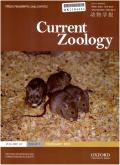Effects of captive-breeding conditions on metabolic and performance traits in an endangered, endemic cyprinidontiform fish
IF 2
2区 生物学
Q2 ZOOLOGY
引用次数: 0
Abstract
Captive breeding and stocking are commonly employed strategies for enhancing fisheries and conserving endangered fish species. However, hatchery-raised fish often exhibit reduced performance in the wild, displaying alterations in physiological, morphological, and behavioral traits. We tested for differences in swimming capacity and metabolic traits between wild and hatchery-reared individuals of the Spanish toothcarp (Aphanius iberus) from two different populations. Furthermore, we experimentally tested if these changes translated into fitness differences after their stocking into the wild. There were significant differences in swimming capacity and metabolic traits between wild and hatchery-reared individuals and also between the two populations. Captive-bred individuals displayed consistently lower metabolic rates than wild individuals from the same population (30-76% lower). Critical swimming speed rather differed between the two populations. Sex-specific differences were observed in maximum and standard metabolic rates, with wild individuals and females generally exhibiting higher values but with some exceptions. During a three-month experiment, survival rates did not significantly differ between wild and captive-bred fish. Captive-bred individuals started smaller but exhibited rapid growth during the experiment. Initially, larger captive-bred fish had lower body condition than their wild counterparts, but these differences progressively diminished. In summary, captive-bred individuals of this fish species showed lower metabolic rates, although the differences with wild individuals slightly depended on sex and size.人工饲养条件对一种濒危特有鲤形目鱼类代谢和性能特征的影响
人工繁殖和放养是提高渔业和保护濒危鱼类物种的常用策略。然而,人工繁殖的鱼类在野外往往表现出性能下降,在生理、形态和行为特征方面出现改变。我们测试了来自两个不同种群的西班牙齿鲨(Aphanius iberus)野生个体和孵化培育个体在游泳能力和新陈代谢特征方面的差异。此外,我们还通过实验测试了这些变化是否会转化为它们放养到野外后的体能差异。野生个体与孵化饲养个体之间,以及两个种群之间,在游泳能力和代谢特征方面存在明显差异。人工饲养个体的新陈代谢率一直低于同一种群的野生个体(低30-76%)。临界游泳速度在两个种群之间也存在差异。最大代谢率和标准代谢率存在性别差异,野生个体和雌性个体的代谢率通常较高,但也有例外。在为期三个月的实验中,野生鱼和人工饲养鱼的存活率没有明显差异。人工饲养的个体一开始较小,但在实验过程中表现出快速生长。起初,体型较大的人工饲养鱼类的身体状况低于野生鱼类,但这种差异逐渐缩小。总之,人工饲养的该鱼种个体的新陈代谢率较低,但与野生个体的差异因性别和大小而略有不同。
本文章由计算机程序翻译,如有差异,请以英文原文为准。
求助全文
约1分钟内获得全文
求助全文
来源期刊

Current Zoology
Agricultural and Biological Sciences-Animal Science and Zoology
CiteScore
3.20
自引率
9.10%
发文量
111
审稿时长
6 weeks
期刊介绍:
About the Journal
Current Zoology (formerly Acta Zoologica Sinica, founded in 1935) is an open access, bimonthly, peer-reviewed international journal of zoology. It publishes review articles and research papers in the fields of ecology, evolution and behaviour.
Current Zoology is sponsored by Institute of Zoology, Chinese Academy of Sciences, along with the China Zoological Society.
 求助内容:
求助内容: 应助结果提醒方式:
应助结果提醒方式:


